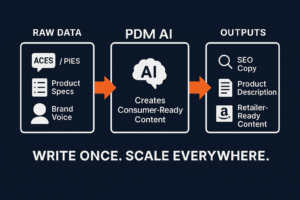Digitally connecting with enthusiast buyers is increasingly challenging in the ever-changing automotive aftermarket world.
Aftermarket companies must provide a great product and engage with their customers in new and exciting ways to succeed. The concept of a catalog is not new; many of the best brands in the industry, like JEGS and Holley, built their companies on the execution of paper catalogs. Today, the paper catalog may be long gone, but providing a concise, punchy directory of your company’s products in one location is regaining traction.
Digital Product Catalogs are particularly effective in the automotive aftermarket space because they effectively showcase products for potential part and accessory buyers in a visually appealing, well-organized way.
Let’s dive into the top 10 reasons it is beneficial to use a digital product catalog in 2024.

1. Accessibility and Convenience
Digital catalogs revolutionize how product information is accessed and managed within the automotive aftermarket industry by ensuring that customers and partners worldwide can obtain vital product details anytime, anywhere.
This 24/7 accessibility is made possible through online platforms that host digital catalogs, eliminating the geographical and temporal limitations associated with traditional physical catalogs. Customers can instantly view updates, such as new product additions, changes in specifications, or pricing adjustments, without waiting for the next print cycle.
For automotive aftermarket businesses, the convenience of updating and maintaining product information in real time is a significant advantage. Digital catalogs can be swiftly updated with a few clicks, ensuring that the catalog always reflects current information. This real-time updating capability reduces the potential for misinformation and significantly lowers the costs and resources typically involved in producing and distributing updated catalogs.
2. Enhanced Customer Experience
Personalized browsing experiences and tailored recommendations are game-changers in the digital marketplace, driving customer engagement.
By analyzing user behavior and preferences, digital catalogs can present products that resonate with individual customers, significantly boosting the likelihood of a sale. High-quality images and interactive elements, such as 360-degree views and zoom features, bring products to life, allowing customers to explore details as if they had the item right before them.
This immersive experience captivates attention and builds confidence in purchase decisions, enhancing overall satisfaction. Personalization and interactivity transform passive browsing into an engaging, dynamic journey, setting the stage for increased loyalty and conversion rates.
3. Increased Sales Opportunities
Digital catalogs open the door to unparalleled sales opportunities by catapulting your reach beyond traditional boundaries.
With the digital world as your playground, you can engage a global audience, breaking down geographical barriers and tapping into new markets. The seamless integration with e-commerce platforms further amplifies this advantage, allowing customers to transition smoothly from browsing to buying in a few clicks. This direct purchase pathway simplifies the shopping experience and significantly shortens the sales cycle, leading to a noticeable uptick in sales volumes.
Digital catalogs are not just a tool for showcasing products; they’re a powerful engine driving revenue growth and market expansion.
4. Improved Searchability and Navigation

Efficient search tools and filters are the backbone of a user-friendly digital catalog, acting as a fast track to finding the perfect product.
By enabling customers to narrow their search based on specific criteria—product type, price range, compatibility, or any other relevant factor—these features significantly reduce the time and effort spent searching for the correct item. The result? A streamlined shopping experience where frustration is minimized, and satisfaction is maximized. This not only enhances the usability of the digital catalog but also plays a crucial role in converting browsers into buyers by making the path from discovery to purchase as smooth as possible.
5. Cost-Effectiveness
Digital catalogs represent a leap in cost-effectiveness compared to their traditional print counterparts.
The initial setup of a digital catalog might require an investment in technology and design, but once up and running, the savings become evident. There’s no need for the recurring expenses of printing, distributing, and updating physical catalogs—a process that is not only costly but also time-consuming. Digital distribution slashes these costs, allowing for real-time updates without additional expense. Over time, these savings accumulate, freeing up resources that can be redirected toward innovation, marketing, or expanding product lines.
The shift to digital is not just a strategic move for enhancing accessibility and engagement; it’s a financially savvy decision that pays dividends in the long run.
6. Data-Driven Insights
Harnessing data-driven insights from digital catalogs is like having a crystal ball for understanding customer behavior and preferences.
Analytics tools dive deep into the user interaction data, revealing patterns, trends, and preferences that were previously invisible. This wealth of information enables businesses to precisely tailor their inventory management and marketing strategies, ensuring that popular products are always in stock and that marketing efforts hit the mark every time. By aligning offerings with actual customer demand, companies boost their sales potential and enhance customer satisfaction.
In short, the strategic use of data from digital catalogs transforms guesswork into informed decision-making, driving efficiency and effectiveness across the board.
7. Enhanced Product Information
Enhanced product information in digital catalogs is a game-changer for customer decision-making.
By offering detailed specifications, compatibility data, and even installation guides, digital catalogs empower customers with all the information they need at their fingertips. This depth and accuracy of product details eliminate guesswork, enabling customers to make informed decisions confidently. It’s not just about listing features; it’s about providing a comprehensive understanding of the product, which, in turn, significantly reduces the likelihood of returns and increases customer satisfaction.
Rich product information is the cornerstone of a transparent, trust-building shopping experience that customers value highly in the digital age.
8. Environmental Benefits
Switching to digital catalogs isn’t just a smart business move; it’s a win for the planet.
By cutting out the need for paper, digital catalogs drastically reduce waste and resource consumption, aligning with broader sustainability goals. This shift not only lessens the environmental impact of catalog production but also resonates with eco-conscious consumers who prioritize green practices. In today’s environmentally aware market, showcasing a commitment to sustainability can enhance a brand’s image and appeal, making digital catalogs a powerful tool for businesses looking to reduce their ecological footprint while connecting with like-minded customers.
9. Competitive Advantage
Adopting digital catalogs offers a significant competitive edge in the fast-paced automotive aftermarket.
By embracing modern technology solutions, companies can streamline operations and deliver an unmatched customer experience. Take, for instance, companies like AutoZone and Advance Auto Parts, which have leveraged digital catalogs to provide instant access to a vast range of parts and accessories, along with detailed product information and compatibility data. This digital prowess enables them to outpace competitors still reliant on traditional methods, attracting a broader customer base and fostering loyalty through convenience and efficiency.
The strategic use of digital catalogs becomes a powerful differentiator, positioning businesses as forward-thinking leaders in the automotive aftermarket space.
10. Integration and Scalability
Digital catalogs seamlessly integrate with core business systems like CRM, ERP, and inventory management, creating a cohesive ecosystem that enhances operational efficiency.
This ease of integration ensures that information flows effortlessly between systems, providing a unified view of customer interactions, stock levels, and sales data. Scalability is another hallmark, allowing businesses to expand their product offerings and adapt to market changes without requiring extensive overhauls. Whether scaling up operations or branching into new markets, digital catalogs adapt to your growth trajectory, ensuring you’re always positioned to capitalize on new opportunities.
A winning combination of integration and scalability makes digital catalogs a powerful tool for businesses seeking a competitive edge in a rapidly evolving market.
PDM Automotive Is Your Digital Partner
PDM Automotive is a platform purpose-built for the automotive aftermarket, tailored to Parts Manufacturers, connecting them to their sales channels, including retailers, online sales channels, and repair facilities. Seamlessly connecting brands and resellers through a single platform, PDM Automotive powers a growing ecosystem of thousands of manufacturers, distributors, and resellers of all sizes for frictionless content flow, driving operational efficiency and sales growth.
Want to learn how to transform your manual content management process into a powerful and automated sales generator? Get in touch with our team today.
More Resources
Elevate Your Brand in the Automotive Aftermarket With These Content Management Strategies



